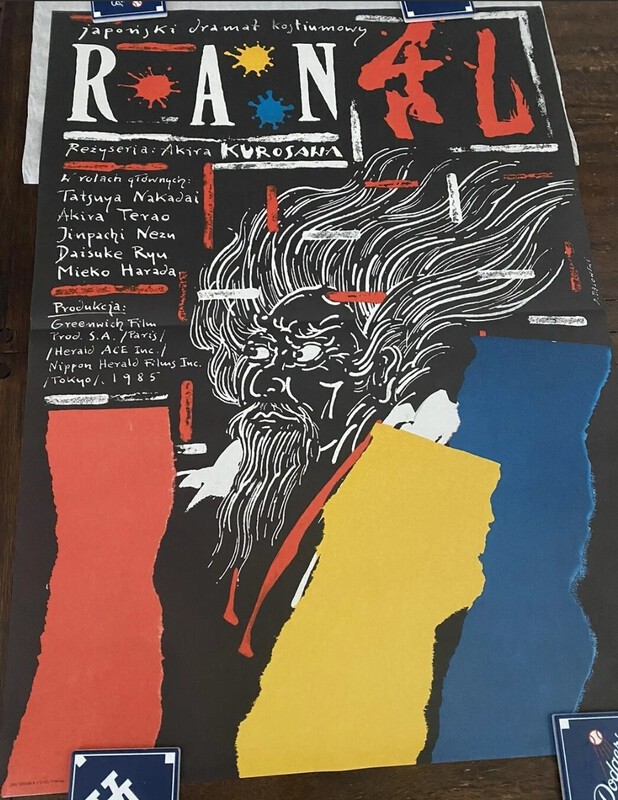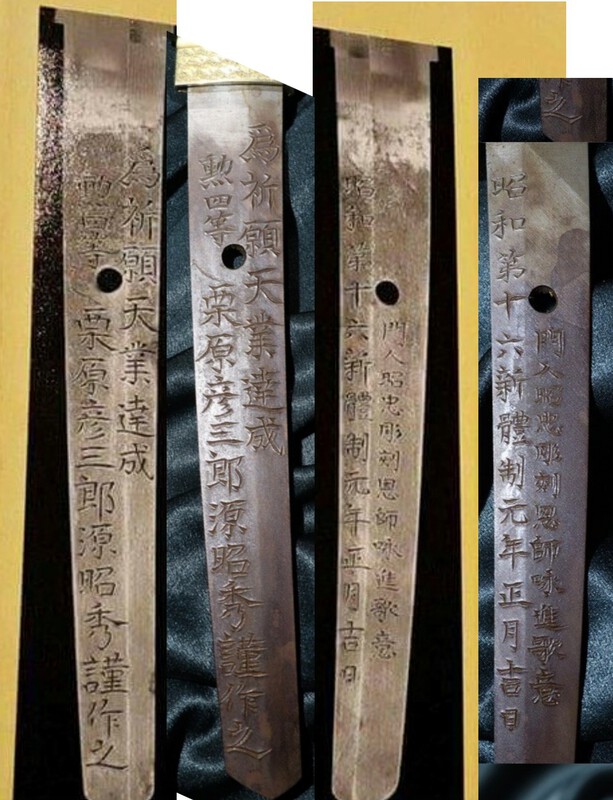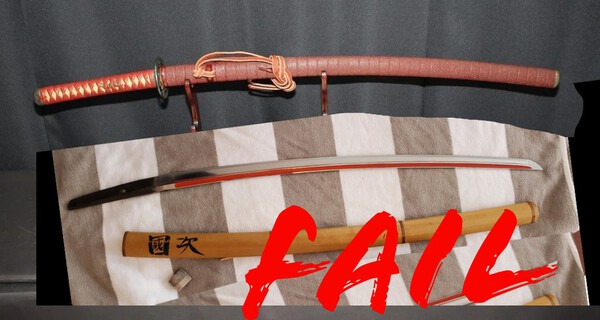-
Posts
805 -
Joined
-
Last visited
-
Days Won
4
Content Type
Profiles
Forums
Events
Store
Downloads
Gallery
Everything posted by waljamada
-
How often do you guys wash your micro fiber towels and is there any special way to clean? Best to just rinse in sink and not put in dryer? Drew that same micro fiber towel that Micheal linked to was also suggested to me by another user and that's a great price for them. I literally just bought four of them because of the price.
-
Really enjoying these videos Ray. Thanks for another one and a very interesting topic.
-

Suggestions of How to Improve the NMB for 2023 ?
waljamada replied to Franco's topic in General Nihonto Related Discussion
I'll start with some things on the other side of the coin. For members/users it would be great if people started (or continued) creating dedicated materials/content off their collections and personal research/interests/knowledge. Videos sharing categories in their collection..."unboxing" videos of new swords that arrive in their collection...collection tours...set up/display tours...a cleaning katanas conversation video (talk about a topic while you clean a blade)...just make content that suits your interests/abilities and what your comfortable with. It can be anything and everything. If you don't want to make videos then little "report" write ups of nihonto in your collection. If you have many blades by a specific smith maybe a little thing on the blades of similarities, what makes you collect that smith etc...if you have a niche, what do you love about it? Are you a tosogu guy? What's in your collection and what drew you to it? Do you have a favorite tsuba...what is it and why? Did you piece together a tsuka set? What was your vision and what did you come up with? Are you a dedicsted military nihonto collector...why....what variations are your favorite...what's in your collection? Any topics that float your boat. Videos can be only 2 minutes long even and filmed on your phone and I do think videos would be the most beneficial type of content to create. Personal opinion. I'm also going to walk this walk (have a few videos planned and in the pipeline) but wanted to do a "call to arms" of sorts for the NMB members/users. We can make a forum post called "NMB Community Theater" or something where we post the links of the videos we create to keep an archive and concentrated source that can keep growing. Write ups can be seperate posts for the current/future collectors to search up, read and enjoy. I'm so grateful for all the old posts and can't express the joy when I find one perfectly targeted on what I was looking for. Edit: Just now saw a great example: Ray Singer posted this video using his collection for Nihonto content...Bravisimo! -

The real "What present(s) did you get?" thread
waljamada replied to Bugyotsuji's topic in General Nihonto Related Discussion
Bought myself two Polish Akira Kurosawa movie posters from the 80's and a Katana I resisted getting for quite a while. -
I need to do this as well...right now I just have the sode (which lacks the cords) simply resting on the shoulders using the yoroi stand and my presentation did not impress when I shared it =|:^) Also, thanks for sharing that uwe.
-
Yes, I truly thank you all. This board is my daily reader and always have it open as a tab on my phone...literally always. This board is the exact resource I needed when first entering the hobby and has the history, resources and wealth of older forum posts to help me grow as my experience, knowledge and interests increases. I've had interactions with probably all the people listed and many more that have been a graceful presence of knowledge. My appreciation for the hobby and art of Nihonto has been enriched by them. I'm extremely grateful for this board and it's members and tip my hat and give a respectful bow to these individuals that together form this community. Bless you gentlemen/gentlewomen and scholars!
-
Brano, What mm macro lense do you use? 24mm?
-

Karakuri or Japanese Automata...anyone have one?
waljamada replied to waljamada's topic in Other Japanese Arts
Brian, sure thing. It really is impressive and the history of it is quite intriguing especially how far back it goes. Wish I could find more examples particularly of the really old ones. -
Randomly came across the neat little niche of Japanese Arts and I find them intriguing...just a cool little science/art. An extremely analog and primitive mechanics done with complexity and intricacies. Anyone have one to share? Karakuri (からくり) Karakuri means a Japanese traditional mechanical doll or miniature, or other mechanical device. In Chinese characters, karakuri is written as 絡繰, 機巧, or 機関, and in the old days, it was written as 唐繰. Originally, karakuri was the general term for mechanical objects, and today, it mostly refers to the Japanese traditional mechanical devices intended for amusement, such as karakuri ningyo (a mechanical doll). Etymology The etymology of karakuri is said to have been the nominalized adverbial form of the Japanese verb 'karakuru,' which means 'move something by pulling the strings attached to it,' and the word karakuri was found to have been used as early as in the late 16th century. The English word "Karakuri" means karakuri ningyo. History of karakuri The oldest karakuri in Japan is said to have been shinansha (an ancient Chinese vehicle with a compass whose needle always pointed south), which came from China in the Heian period. It was a practical karakuri that always pointed south, utilizing the differential motion of the left and right wheels. A description of shinansha is also seen in "Sangokushi" (Annals of the Three Kingdoms). Volume 24 of "Konjaku Monogatari" (Tales of Now and Then), written in the last days of the Heian period, says that Imperial Prince Kaya produced a karakuri. Therefore, karakuri has a long history. Incidentally, in those days, only aristocrats enjoyed karakuri. Dashi karakuri (karakuri placed on a parade float) in Takayama Festival is famous. Although karakuri is unique to Japan, its origin owed much to Western techniques that were introduced into Japan in the Muromachi period. When a harquebus came to Japan, mechanisms, such as that of a watch, also came. At that time, mechanical devices were generally called karakuri. The devices were watched with curiosity, since the devices themselves were peculiar things for Japanese at that time. And so, Japanese in those days associated the word karakuri with an amusing (or surprising) thing. From around the 17th century, craftsmen began to produce karakuri ningyo by applying some techniques, including gears used in a watch and other things, to the devices for the movements of the doll. At first, it was owned only by daimyo (Japanese feudal lords) and others as a toy of refined taste, but as it was shown to the public and gained popularity, it spread nationwide. Professional craftsmen were born, and they crafted extremely sophisticated dolls. In those days, only aristocrats enjoyed karakuri ningyo. In 1662, Omi TAKEDA gave a performance of a play of karakuri ningyo at Dotonbori, Osaka. This play is said to have descended to dashi karakuri in some local communities. During the Kyoho era in the early 18th century, a new land-ship car (today's tricycle) was invented by Kuheiji Tokimitsu HIRAISHI, a feudal retainer of the Hikone domain. In the 19th century, at Tsukuba, Igashichi IIZUKA (so-called 'Karakuri Iga') invented a man-powered plane and a karakuri ningyo that went on an errand to a sake (Japanese liquor) shop. The 18th and 19th centuries saw the creation of the most sophisticated works. In the last days of the Edo period, Benkichi ONO, who was called the Second Gennai HIRAGA in Kaga (Gennai HIRAGA was a great inventor in the middle of the Edo period), invented an air gun, a miniature of a steamship, and a camera. Varieties of karakuri Zashiki karakuri (an indoor karakuri) Karakuri ningyo and others Karakuri gangu (a mechanical toy) : From many years ago, local communities all over Japan have produced various toys of their own as a folkcraft, or as a folk toy, equipped with various devices, and even today, many of these toys are sold as souvenirs. The devices of a 'tin toy,' which once backed up the Japanese export industry, originated mostly from karakuri gangu. Karakuri bungu (trick stationery) Karakuri gasa (a trick umbrella): Karakuri gasa concretely meant a Japanese-style umbrella (oddly, also described as a Chinese-style umbrella), and the name karakuri gasa was given because a mere canopy of Chinese origin was changed into the convenient tool equipped with the device for opening and closing in Japan. Famous karakuri Yumihiki Doji (archer doll). Crafted by Hisashige TANAKA. It is zashiki karakuri, whose doll takes an arrow out of a basket, fits the arrow to a string of a bow, and shoots at a target. The movements of the doll are controlled only with coil springs, cams, and strings. The doll shoots several arrows, and when one of these arrows goes off the target --- this is intentionally crafted as such --- the doll expresses regret - when it hits the target, the doll expresses joy - with its head movement. This doll is said to be the best masterpiece of all Edo karakuri. Two original yumihiki doji were found at the house of the Maekawa family in Fushimi in 1990. At present, one of them is owned by Toyota Motor Corporation, and another belongs to the National Museum of Nature and Science. A kit of a model doll that makes the same movements as the above is sold by Gakken Holdings Co., Ltd. Chahakobi ningyo (a tea-serving doll) Chahakobi ningyo is zashiki karakuri that holds a tray. This is a typical karakuri. When you place a cup of tea on the tray, the doll carries it to a guest, and when the guest picks it up, the doll stops. The carrying distance is set beforehand. When the guest places the empty cup on the tray after drinking the tea, the doll turns itself, carries the cup to you, and rolls to a stop. The doll's movements are controlled only with coil springs, gears, cams, and strings. The doll often seen today is a reproduction, which is based on the design included in "Karakuri zui" (Compilation of Illustrated Mechanical Arts), an old book written by karakuri craftsman Hanzo HOSOKAWA in 1796. There has not been found any original chahakobi ningyo produced by a craftsman in the Edo period. Karakuri mikuji (a mechanical messenger of a fortune-telling slip) Karakuri mikuji exists at Nishiki Tenman-gu Shrine situated on the eastern edge of Nishiki Food Market in Kyoto City. When you come near to the karakuri mikuji, kagura (the sacred music performed at shrines) and a mechanical Japanese lion dance automatically begin, and when you put coins into a box and select a fortune-telling slip from among the six kinds (including that in English, that in both Japanese and English, and that for a child), the mechanical lion brings you the slip, performing the Japanese lion dance in accord with kagura --- these comical devices have become popular. Karakuri and the robot Between the Edo karakuri ningyo and the present robot, there exists no technical link, but not a few cultural links do exist. Some say that Japanese feel familiar with robots because they were used to seeing a karakuri ningyo and the like, in contrast to the Western people who feel antipathy to robots. And others say the research and development of robots is active in Japan partly because of the tradition of karakuri. Mechanical dolls and the like seen in places other than Japan At a church or an old municipal office in Europe, a mechanical clock is often seen. Most of the old mechanical dolls seen outside Japan do a simple reciprocation, such as sawing and ax-swinging. In the 19th century, a mechanical doll called an automaton appeared, which was crafted to mimic human movements. Some automata are said to have had a conversation with a human, done a calculation, or played chess.
-
Bridges, Those "souvenir" swords show up semi-consistently. They are authentic period pieces but tend to have a bit less interest in the general military collecting field that have some "know". For the price of the piece on the duck website you can for sure find, with some patience, a type 98 showato. It wont be perfect. The blade on the duck website looks to me like an arsenal NCO blade in the gunto mounts. I recognize it via the bohi (which are also on Japanese blades), shape and kissaki but the photos aren't great so I could be wrong. I respect and understand the gusto as I've been through it. Also couldn't hurt to post what you'd like to find and your price range on the "Wanted to Buy" section if you haven't already. Tried to hunt some things: https://stcroixblades.com/shop/products/Japanese-model-1889-naval-prison-shore-patrol-sword-anchor-marked-rare-navy/ No idea about this seller: https://www.bowlinggreendrummer.com/Japanese-officer-s-wwii-katana-sword-scb-signed Komonjo but still: https://www.ebay.com/itm/134359224972?mkcid=16&mkevt=1&mkrid=711-127632-2357-0&ssspo=i-cU9RKGRia&sssrc=2349624&ssuid=_371BgsbQ6q&var=&widget_ver=artemis&media=COPY Like I mentioned...gonna really help you if to have patience and wait for the right piece to come across you.
-
I don't know...but I want it....
-
Context: I focus on the lower price range of the market so my experiences/opinions will be from that perspective. I started collecting nihonto about 4/5 years ago and I don't think prices are up 30%. There's always more sellers asking more then somethings worth than otherwise but if you watch auctions then prices have been pretty stable with some fluctuation. For a specific example, 3 years ago on eBay I bought a Koa Isshin Mantetsu in Type 98 for $1700 and I just saw one that also went for $1700 a few days ago; both werent perfect but still solid pieces. Also seen them go for a good chunk more but the "bottom" prices at the auctions throughout the variety of nihonto categories still appear the same as when I started except for when (at minimum) two people want a thing and therefore bidding does what bidding does. I think it's a good time to buy, especially from Japan, but I've noticed the same "stock" just sitting around. Haven't been in this hobby that long but already saw quite a few little up and downs. I started at a down, saw an up, waited for a down...rinse and repeat. The fluctuations between an up and down though aren't anything crazy...in general 5% to 15% with a few "outstanding buys" scattered about.
-

Hokke Katana - 78CM Nagasa - TOKUBETSU HOZON
waljamada replied to JakeNYC's topic in For Sale or Trade
My heart says yes...my wallet says no. She's a beauty! -
Congrats, huge fan of that menpo! Haven't seen one before fully decorated with linework like that.
-
One of the reasons that my brain attributed to "logic" that made me hesitant to buy was my experience as a collector in other art fields. In my experience in the other art fields personal commission pieces and especially high level gifts are not kosher to duplicate and sell by the same artist. Reason being it diminishes the uniqueness, importance and value of that original piece. There's some examples of works being copied by the original artist but usually after some solid amount of time has passed. For example if you crafted a specially made blade for the purpose of gifting to the Emperor but then sell other versions of the same sword it seems you risk offenses. Especially when it's the Emperor.... The making of multiple versions to work on side by side in case of mistake and presenting the best version makes sense. Then over time the "2nd version" finding its way to market also makes sense. The thing with these two blades that also made me uneasy is that the carvings used different styles to depict certain aspects. The water waves/ripples etc...was done differently. The ships siding was done differently, the hair differently, the mountains....and the hozon one simply looks more expertly carved. The water effects and scale/perspective stand out most to me as the largest difference in artistry. Just gave me pause that it was done by the same hand but also could just be experimenting between versions to find the best effect... The sword, either way, is quite impressive in its own right but the process, kosher-ness of selling duplicates and high level gifting culture questions are what popped in my head beyond the fun I had of really studying, researching and comparing each one.
-
Saw this beautiful blade for sale and just found it interesting. Lead me down a research rabbit hole. It appears to me there are two blades incredibly similar yet slightly different. One has had hozon papers issued and one doesn't. According to the write ups the one with Hozon papers is listed as 1940 and the one without 1941. The earlier 1940 version was attributed as a gift to Hirohito and was in an awesome koshirae. At quick glance they appear the same blade, the horimonos are of the same poetry and imagery yet differ in the details and the hamons are different. Perhaps the team got back together for a second go or a special order of a near duplicate version? Either way found it interesting there are two versions of a gift sword. Almost made a hard go for this blade but decided I didn't know enough to stick my neck out. Congrats to whomever the buyer was!
-
I know that blade as I've been tempted by it as well. It also has this area in the photo attached below. With those areas you would just keep them stabilized rather than fully re-polish. I think that blade wouldn't allow much metal to be removed before becoming simply too thin of a blade as its already a skinny blade without much "niku" or meat/metal to work with. So simply keeping it stable and "killing" any of the active rust would be my suggested course.
-
It's a seki stamped wwii era (id guess early 1940s) showato (typically machine assisted, non-tamagahane and oil quenched..esentially non-traditionally forged) blade in some nice lookin kai gunto (navy) mounts. The saya looks to be in great shape from what is visible and that rough leather cover did its job. Sadly can't help with the translation of the mei though.
-
Preface: I'm still a nihonto newbie. Repair would be polishing which is expensive so upkeep is probably the path here. Just keep the blade clean and oiled (with choji oil which does stabalize rusting) and never touch the blade with your hand/fingers. It isn't necessary to clean and re-oil the blade everytime you take it out of shirasaya. Truth be told, I bet that little bit of corrossion was already there. If it just happened I assume you would have seen some active red rust (darker blackish rust is "dead" rust). I actually started taking detailed pictures of my blades right when I get them so that when I later see some small flaw I never noticed I am able to check the pics to see if I did it or it was simply there the whole time. I have yet to find a new little flaw that I actually did to a blade but without those pics I would have been convinced it was me. It's not hard to miss a small flaw. The last polisher possibly even left that there to refrain from having to remove too much metal for a non-fatal flaw. It's a small area and the blade from that pic still seems quite nice.
-
Maruce, thank you! I was too slow though...already on hold.
-

So what's a weird deal-breaker for you?
waljamada replied to Brian's topic in General Nihonto Related Discussion
Some of my...."not lovin it"s.... Horimono wise: In general I second the -not that into dragons- thing but the semi-standard dragon horimonos like you see on guntos. Horimono with faces that look kinda silly. Blade wise: too skinny of blades, not a big fan of straighter blades. Post WWII made blades. Koshirae: Bad tsuka ito wrapping job. Most swan/crane tsubas..most dragon tsubas. -
Appreciate the kind words gentlemen. Is a bit of salve to the burn. I'll see if it works on any of my blades and maybe upgrade their saya...otherwise it's going above a built in cabinet next to a mark twain bust.
-
Well boys....it was a failure. Tried to match the blade below to it....it was so darn close....the length was right....the sori in theory was right...but I discovered this blade has a sharper sori turn on the top 1/3rd which makes it catch at a certain point in the saya. I lost the heart and didn't even try the tsuka...I'll give that a go tomorrow. Bummer. $590 bucks semi-wasted =|:^( *photos are not exactly to scale















